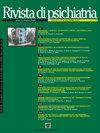[Ketamine's fast-acting antidepressant mechanisms: state of the art and new research perspectives].
IF 1
4区 医学
Q4 PSYCHIATRY
引用次数: 0
Abstract
About a third of patients with major depressive disorder (MDD) do not have an adequate response to first-line antidepressant treatment, i.e., develop a treatment-resistant depression (TRD). The partial understanding of MDD pathophysiology currently constitutes the major barrier to clinical and research progress on this topic. However, recent advances in genome editing techniques as well as in induced pluripotent stem cells (iPSC) technology are offering unprecedented opportunities in both human disease modelling and drug discovery. These technology progresses have been enabling to set up disease-relevant patient-specific in vitro disease modeling for various mental disorders. The resulting models have the potential to significantly improve pathophysiologic understanding of MDD and then overcome some limitations inherent to animal and post-mortem models. More recently, psychiatry started to deal with the fast acting antidepressant ketamine and its derivates. Although ketamine appears to have the potential to transform the treatment of depression, its specific mechanisms of action are only partially known. Such knowledge is necessary to develop a model to understand the mechanisms behind fast-acting antidepressants, which may enable the discovery of novel glutamatergic compounds for the treatment of MDD. After discussing both the current understanding of ketamine's mechanisms of action, and the state of the art of human iPSC technology, the authors will introduce the implementation of a TRD model based on iPSC human technology and aimed at studying the ketamine's fast acting antidepressant mechanisms of action.[氯胺酮的快速抗抑郁机制:最新研究现状和新研究视角]。
大约三分之一的重度抑郁症(MDD)患者对一线抗抑郁药物治疗没有足够的反应,即发展为难治性抑郁症(TRD)。目前,对重度抑郁症病理生理的不完全了解构成了该主题临床和研究进展的主要障碍。然而,基因组编辑技术以及诱导多能干细胞(iPSC)技术的最新进展为人类疾病建模和药物发现提供了前所未有的机会。这些技术进步已经能够建立各种精神障碍的疾病相关患者特异性体外疾病模型。由此产生的模型有可能显著提高对重度抑郁症的病理生理学理解,从而克服动物和死后模型固有的一些局限性。最近,精神病学开始处理速效抗抑郁药氯胺酮及其衍生物。虽然氯胺酮似乎有可能改变抑郁症的治疗方法,但其具体的作用机制仅部分为人所知。这些知识对于建立一个模型来理解速效抗抑郁药背后的机制是必要的,这可能有助于发现治疗重度抑郁症的新型谷氨酸能化合物。在讨论了氯胺酮的作用机制和人类iPSC技术的现状后,作者将介绍基于iPSC人类技术的TRD模型的实现,旨在研究氯胺酮的快速抗抑郁作用机制。
本文章由计算机程序翻译,如有差异,请以英文原文为准。
求助全文
约1分钟内获得全文
求助全文
来源期刊

Rivista di psichiatria
医学-精神病学
CiteScore
5.00
自引率
3.70%
发文量
31
审稿时长
6-12 weeks
期刊介绍:
Gli interessi della rivista riguardano l’approfondimento delle interazioni tra mente e malattia, la validazione e la discussione dei nuovi strumenti e parametri di classificazione diagnostica, la verifica delle prospettive terapeutiche farmacologiche e non.
 求助内容:
求助内容: 应助结果提醒方式:
应助结果提醒方式:


